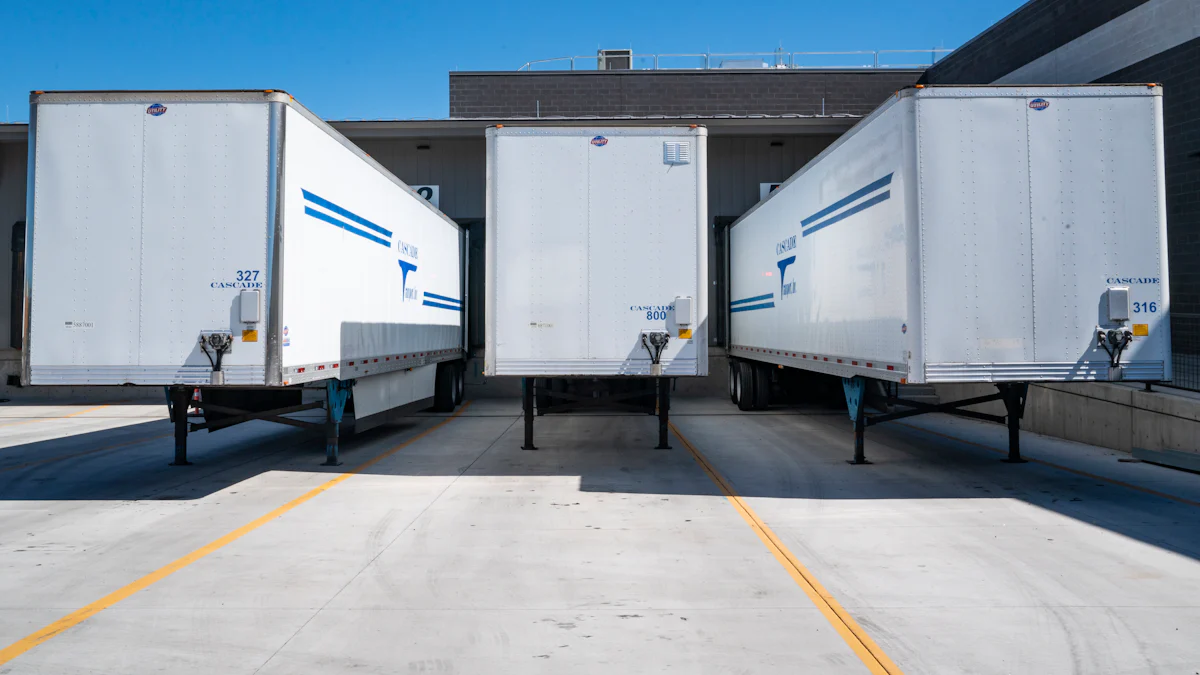In-Depth Analysis of JUSDA's C2M2C Model: Achieving End-to-End Supply Chain Transparency

Transparency plays a critical role in modern supply chains. It involves disclosing suppliers to both private customers and public consumers, ensuring that every step in the supply chain is visible. JUSDA, a leader in global supply chain services, introduces its innovative C2M2C Model to enhance this transparency. This model aims to streamline the entire supply chain process, providing a direct connection between manufacturers and consumers. By exploring JUSDA's approach, businesses can understand how transparency impacts efficiency and trust within the supply chain.
Understanding JUSDA's C2M2C Model
Overview of the C2M2C Model
The C2M2C Model stands as a transformative approach in supply chain management. It represents a seamless integration from Customer to Manufacturer to Consumer, ensuring that every link in the supply chain operates with maximum efficiency and transparency. This model covers the entire journey of a product, from raw material procurement to the final delivery to consumers.
Key Components
Procurement: The model begins with sourcing raw materials. JUSDA ensures that this step is optimized for cost-effectiveness and quality.
Manufacturing: The next phase involves transforming raw materials into finished products. The C2M2C Model emphasizes efficiency and precision during this stage.
Distribution: Once products are manufactured, they move through a streamlined distribution network. This ensures timely delivery to consumers.
Consumer Feedback: The model incorporates consumer feedback to continuously improve processes and products.
Unique Features
Vertical Integration: The C2M2C Model integrates all stages of the supply chain, reducing lead times and enhancing operational agility.
Innovation and Technology: JUSDA employs cutting-edge technology to facilitate real-time data sharing and collaboration across the supply chain.
Cost-Effectiveness: By optimizing each step, the model reduces unnecessary costs, benefiting both manufacturers and consumers.
Historical Development
The C2M2C Model did not emerge overnight. It evolved through years of experience and innovation in supply chain management.
Evolution of the Model
JUSDA leveraged its extensive experience to develop the C2M2C Model. Initially, the focus was on improving individual components of the supply chain. Over time, JUSDA recognized the need for a holistic approach, leading to the integration of all stages into a single, cohesive model.
Milestones Achieved
Implementation Across Industries: The model has been successfully implemented in various sectors, including electronics, automotive, and FMCG.
Technological Advancements: JUSDA continuously integrates new technologies, such as IoT and cloud computing, to enhance the model's capabilities.
Global Reach: With over 155 service points worldwide, JUSDA's C2M2C Model has achieved a global presence, supporting diverse industries and markets.
The C2M2C Model represents a significant advancement in supply chain management. By understanding its components and historical development, businesses can appreciate its potential to revolutionize their operations.
The Importance of Supply Chain Transparency
Current Challenges in Supply Chains
Lack of Visibility
Supply chains often struggle with visibility. Many companies find it difficult to track products from origin to destination. This lack of visibility can lead to inefficiencies and increased risks. Without clear insight into each step, businesses may face delays and unexpected costs. Visibility allows companies to see where a product came from, but transparency takes it further by enabling action on insights gained.
Inefficiencies and Risks
Inefficiencies in supply chains arise from poor communication and outdated processes. These inefficiencies can result in wasted resources and time. Risks also increase when companies cannot anticipate disruptions or changes in demand. Transparency helps manage these risks more effectively by providing a clear view of the entire supply chain. It allows businesses to identify potential issues before they escalate.
Benefits of Transparency
Improved Decision Making
Transparency enhances decision-making processes. When companies have access to comprehensive data, they can make informed choices. This data-driven approach reduces guesswork and improves accuracy. By understanding the flow of products and information, businesses can optimize operations and allocate resources more efficiently.
Enhanced Customer Trust
Customers value transparency. They want to know where products come from and how they are made. By disclosing suppliers and production processes, companies build trust with consumers. This trust leads to stronger customer relationships and brand loyalty. Transparency not only satisfies consumer curiosity but also demonstrates a commitment to ethical practices.
"Transparency is the process of disclosing suppliers to private customers and/or public consumers," highlighting its role in building trust and accountability.
How JUSDA's C2M2C Model Enhances Transparency

JUSDA's C2M2C Model significantly enhances transparency within the supply chain. By integrating advanced mechanisms and learning from real-world applications, JUSDA ensures that every stakeholder benefits from a clear and efficient supply chain process.
Mechanisms for Transparency
Real-Time Data Sharing
Real-time data sharing stands as a cornerstone of the C2M2C Model. JUSDA employs cutting-edge technology to facilitate instantaneous communication across all stages of the supply chain. This approach allows manufacturers, distributors, and consumers to access up-to-date information about product status and location. Real-time data sharing reduces delays and errors, ensuring that all parties have the information they need to make informed decisions. By providing a continuous flow of information, JUSDA enhances the visibility and reliability of the supply chain.
Integrated Systems
The C2M2C Model relies on integrated systems to streamline operations. JUSDA connects various components of the supply chain through a unified platform, enabling seamless collaboration and coordination. These integrated systems allow for efficient management of resources and processes, reducing redundancies and optimizing performance. By linking procurement, manufacturing, and distribution, JUSDA ensures that each step in the supply chain aligns with the overall objectives. This integration not only improves transparency but also enhances the agility and responsiveness of the supply chain.
Case Studies
Successful Implementations
Several industries have successfully implemented JUSDA's C2M2C Model, demonstrating its effectiveness in enhancing transparency. For instance, in the electronics sector, companies have streamlined their supply chain processes from raw materials to end consumers. This implementation has resulted in improved efficiency and reduced lead times. The automotive industry also benefits from the C2M2C Model, achieving greater visibility and control over their supply chains. These successful implementations highlight the model's versatility and adaptability across different sectors.
Lessons Learned
From these implementations, valuable lessons have emerged. One key takeaway is the importance of embracing technology to facilitate transparency. Companies that invest in real-time data sharing and integrated systems experience significant improvements in supply chain performance. Another lesson is the need for continuous evaluation and optimization. By regularly assessing the effectiveness of the C2M2C Model, businesses can identify areas for improvement and adapt to changing market conditions. These lessons underscore the model's potential to revolutionize supply chain management.
Measuring the Value of Transparency
Transparency in supply chains offers significant value, which can be measured through specific metrics and its impact on business performance. By understanding these aspects, companies can better appreciate the benefits of adopting transparent practices.
Key Performance Indicators (KPIs)
To evaluate the effectiveness of transparency, businesses rely on Key Performance Indicators (KPIs). These metrics provide a clear picture of how well transparency initiatives are performing.
Metrics for Success
Supplier Visibility: This metric assesses the extent to which a company can track its suppliers. High visibility indicates a transparent supply chain, allowing businesses to identify and address potential risks promptly.
Data Accuracy: Accurate data is crucial for transparency. Companies measure the precision of their data to ensure that all stakeholders have reliable information for decision-making.
Response Time: This KPI evaluates how quickly a company can respond to supply chain disruptions. Faster response times often result from improved transparency, as businesses can act swiftly based on real-time insights.
Customer Satisfaction: Transparency often leads to higher customer satisfaction. By measuring customer feedback and loyalty, companies can gauge the success of their transparency efforts.
Tools for Measurement
Procurement Dashboards: These tools provide a comprehensive view of the supply chain, enabling businesses to monitor supplier performance and identify areas for improvement.
Network Analytics: By analyzing data from various sources, companies can gain insights into supply chain dynamics and enhance transparency.
Real-Time Tracking Systems: These systems offer up-to-date information on product location and status, facilitating better decision-making and risk management.
Impact on Business Performance
Transparency not only improves operational efficiency but also positively influences financial outcomes.
Cost Reduction
Transparent supply chains help reduce costs by minimizing inefficiencies and waste. Companies can identify bottlenecks and streamline processes, leading to significant savings. For instance, real-time data sharing within the C2M2C Model allows businesses to optimize inventory levels and reduce excess stock, thereby lowering storage costs.
Revenue Growth
Transparency fosters trust among consumers, which can drive revenue growth. Customers who understand the origins and production processes of products are more likely to remain loyal and make repeat purchases. The C2M2C Model enhances this trust by providing clear and accurate information throughout the supply chain. As a result, businesses can strengthen their brand reputation and expand their market share.
"Transparency goes way beyond just visibility of the supply chain," emphasizing the importance of taking action on insights gained to manage risks effectively.
By measuring the value of transparency through KPIs and understanding its impact on business performance, companies can make informed decisions to enhance their supply chain operations. The C2M2C Model exemplifies how transparency can lead to cost reduction and revenue growth, ultimately benefiting both businesses and consumers.
Leveraging Data for Supply Chain Optimization
Data Collection and Analysis
Data serves as the backbone of supply chain optimization. Companies must gather accurate and relevant data to make informed decisions. Data serves as the backbone
Sources of Data
Internal Systems: Companies collect data from their own operations. This includes inventory levels, production schedules, and sales figures. Internal data provides insights into current performance and potential areas for improvement.
External Partners: Suppliers and logistics providers offer valuable data. This information helps companies understand lead times, delivery schedules, and supplier performance. By collaborating with partners, businesses can enhance their supply chain visibility.
Market Trends: Analyzing market trends allows companies to anticipate changes in demand. Data from industry reports, consumer behavior studies, and economic indicators guide strategic planning.
Analytical Techniques
Descriptive Analytics: This technique summarizes historical data to identify patterns and trends. Companies use descriptive analytics to understand past performance and make data-driven decisions.
Diagnostic Analytics: Diagnostic analytics delves deeper into data to uncover the reasons behind specific outcomes. By identifying root causes, businesses can address issues and improve processes.
Prescriptive Analytics: This advanced technique suggests actions based on data analysis. Prescriptive analytics helps companies optimize their supply chain by recommending the best course of action.
Predictive Analytics
Predictive analytics plays a crucial role in supply chain optimization. It uses historical data and statistical models to forecast future events.
Forecasting Demand
Demand Patterns: Companies analyze historical sales data to identify demand patterns. Understanding these patterns helps businesses anticipate future demand and adjust production accordingly.
Seasonal Trends: Many industries experience seasonal fluctuations in demand. Predictive analytics enables companies to prepare for these changes by adjusting inventory levels and production schedules.
Consumer Behavior: By analyzing consumer behavior data, companies can predict shifts in demand. This insight allows businesses to tailor their offerings to meet customer needs.
Risk Management
Identifying Risks: Predictive analytics helps companies identify potential risks in the supply chain. By analyzing data from various sources, businesses can anticipate disruptions and develop contingency plans.
Mitigating Disruptions: Companies use predictive analytics to assess the impact of potential disruptions. This information enables them to take proactive measures to minimize risks and maintain supply chain continuity.
Optimizing Resources: Predictive analytics allows companies to allocate resources efficiently. By forecasting demand and identifying risks, businesses can optimize inventory levels, production schedules, and transportation routes.
"Data is the new oil," highlighting its critical role in driving supply chain optimization. By leveraging data collection and analysis, along with predictive analytics, companies can enhance their supply chain operations and achieve greater efficiency.
Actionable Steps for Implementing the C2M2C Model
Implementing JUSDA's C2M2C Model requires a structured approach to ensure success. This section outlines actionable steps that organizations can follow to integrate this model effectively into their supply chain operations.
Initial Assessment
Before diving into implementation, organizations must conduct a thorough initial assessment. This step involves understanding the specific needs and setting clear objectives.
Identifying Needs
Evaluate Current Processes: Organizations should start by evaluating their existing supply chain processes. This evaluation helps identify areas that require improvement and align with the C2M2C Model's capabilities.
Determine Resource Availability: Assessing available resources, including technology, personnel, and budget, is crucial. This assessment ensures that the organization can support the changes needed for the C2M2C Model.
Analyze Market Demands: Understanding market demands and consumer expectations helps tailor the model to meet specific industry needs. This analysis ensures that the model aligns with business goals and customer satisfaction.
Setting Objectives
Define Clear Goals: Organizations should set clear, measurable goals for implementing the C2M2C Model. These goals might include improving transparency, reducing lead times, or enhancing customer satisfaction.
Establish Key Performance Indicators (KPIs): KPIs provide a framework for measuring success. Organizations should establish KPIs that align with their objectives, such as supplier visibility, data accuracy, and response time.
Create a Timeline: A realistic timeline helps manage the implementation process efficiently. Organizations should outline key milestones and deadlines to ensure timely progress.
With a clear understanding of needs and objectives, organizations can develop a robust implementation strategy. This strategy should focus on a phased approach and continuous improvement.
This strategy should focus on a phased approach and continuous improvement.
Phased Approach
Pilot Testing: Organizations should begin with a pilot test of the C2M2C Model in a specific area of the supply chain. This test allows for identifying potential challenges and making necessary adjustments before full-scale implementation.
Gradual Rollout: After successful pilot testing, organizations can gradually roll out the model across different supply chain components. This phased approach minimizes disruptions and allows for smooth integration.
Monitor Progress: Continuous monitoring during the rollout phase ensures that the model operates as intended. Organizations should track KPIs and gather feedback to make informed adjustments.
Continuous Improvement
Regular Evaluation: Organizations should regularly evaluate the performance of the C2M2C Model. This evaluation helps identify areas for improvement and ensures that the model remains aligned with business goals.
Incorporate Feedback: Feedback from stakeholders, including suppliers, employees, and customers, provides valuable insights. Organizations should use this feedback to refine processes and enhance the model's effectiveness.
Adapt to Changes: The supply chain landscape is dynamic, and organizations must adapt to changes in technology, market demands, and consumer preferences. Continuous improvement ensures that the C2M2C Model remains relevant and effective.
By following these actionable steps, organizations can successfully implement JUSDA's C2M2C Model, achieving enhanced transparency and efficiency in their supply chain operations.
Overcoming Challenges in Implementation
Implementing JUSDA's C2M2C Model can transform supply chain operations, but it also presents challenges. Organizations must address these obstacles to ensure a smooth transition and maximize the model's benefits.
Common Obstacles
Resistance to Change
Many organizations face resistance when introducing new models or processes. Employees may feel comfortable with existing systems and hesitate to adopt new methods. This reluctance can slow down implementation and hinder progress. Resistance often stems from fear of the unknown or concerns about job security. To overcome this, organizations need to foster a culture of openness and adaptability.
Technical Barriers
Technical barriers pose another significant challenge. Integrating advanced technologies into existing systems can be complex. Companies may encounter issues with compatibility, data migration, or system downtime. These technical hurdles can disrupt operations and delay implementation. Organizations must prepare for these challenges by investing in the right technology and expertise.
Solutions and Best Practices
Change Management
Effective change management can help organizations overcome resistance. Leaders should communicate the benefits of the C2M2C Model clearly and consistently. They must involve employees in the process, addressing their concerns and providing training. By creating a supportive environment, organizations can ease the transition and encourage acceptance.
Communication: Regular updates and open dialogue help build trust and understanding.
Training Programs: Providing comprehensive training ensures employees feel confident using new systems.
Employee Involvement: Involving staff in decision-making fosters a sense of ownership and commitment.
"Change is the only constant," emphasizing the importance of adaptability in today's dynamic business environment.
Technology Adoption
To tackle technical barriers, organizations should adopt a strategic approach to technology integration. This involves selecting the right tools and ensuring seamless compatibility with existing systems. Companies can benefit from partnering with experienced technology providers who offer support and guidance throughout the process.
Technology Assessment: Evaluate current systems and identify areas for improvement.
Expert Consultation: Engage with technology experts to ensure successful integration.
Continuous Monitoring: Regularly assess system performance and make necessary adjustments.
*Sharp's collaboration with Jusda through SHARP JUSDA LOGISTICS (SJL) exemplifies successful technology adoption.* By leveraging Jusda's expertise, Sharp overcame supply chain inefficiencies and improved forecasting accuracy. This partnership highlights the value of strategic collaboration in overcoming technical challenges.
By addressing common obstacles and implementing best practices, organizations can successfully integrate JUSDA's C2M2C Model. This approach not only enhances supply chain transparency but also drives operational efficiency and growth.
Future Trends in Supply Chain Transparency

The landscape of supply chain transparency continues, driven by technological advancements and innovative practices. Companies like JUSDA are at the forefront, leveraging these trends to enhance their C2M2C Model. This section explores emerging technologies and the role of artificial intelligence in shaping the future of supply chain transparency.
Emerging Technologies
Blockchain
Blockchain technology offers a revolutionary approach to supply chain transparency. By providing a decentralized and immutable ledger, blockchain ensures that every transaction is recorded and accessible to all stakeholders. This transparency reduces fraud and errors, as each participant can verify the authenticity of the data. JUSDA integrates blockchain into its C2M2C Model, allowing for secure and transparent tracking of products from manufacturer to consumer. This integration not only enhances trust but also streamlines operations by reducing the need for intermediaries.
Internet of Things (IoT)
The Internet of Things (IoT) plays a crucial role in enhancing supply chain transparency. IoT devices collect real-time data from various points in the supply chain, providing valuable insights into product location, condition, and status. JUSDA utilizes IoT technology within its C2M2C Model to monitor and manage logistics processes efficiently. By connecting devices and systems, JUSDA ensures seamless communication and coordination across the supply chain. This connectivity enables proactive decision-making, reducing delays and improving overall efficiency.
The Role of Artificial Intelligence
Automation
Artificial intelligence (AI) drives automation in supply chain operations, significantly enhancing transparency. AI-powered systems automate routine tasks, such as inventory management and order processing, freeing up human resources for more strategic activities. JUSDA incorporates AI into its C2M2C Model to optimize logistics processes and improve accuracy. Automation reduces human error and increases the speed of operations, ensuring that products reach consumers promptly and reliably.
Enhanced Analytics
AI also enhances analytics capabilities, providing deeper insights into supply chain dynamics. By analyzing vast amounts of data, AI identifies patterns and trends that inform strategic decisions. JUSDA leverages AI-driven analytics to forecast demand, manage risks, and optimize resource allocation within its C2M2C Model. These insights enable JUSDA to anticipate changes in the market and adapt its operations accordingly. As a result, JUSDA maintains a competitive edge by delivering superior service and meeting consumer expectations.
"By leveraging real-time data and advanced algorithms, JUSDA ensures proactive decision-making to optimize logistics processes and enhance overall efficiency."
In conclusion, emerging technologies and AI play pivotal roles in advancing supply chain transparency. JUSDA's commitment to integrating these innovations into its C2M2C Model demonstrates its dedication to leading the industry in transparency and efficiency. As these trends continue to evolve, companies must embrace them to remain competitive and meet the growing demands of consumers.
The C2M2C model offers numerous benefits, including enhanced transparency, improved efficiency, and stronger customer trust. By integrating real-time data sharing and advanced technologies, JUSDA's approach revolutionizes supply chain management. Businesses should adopt transparent practices to stay competitive and meet consumer demands. Transparency not only builds trust but also drives operational success. As technology evolves, supply chain transparency will continue to advance, offering new opportunities for innovation and growth. Embracing these changes will position companies at the forefront of industry transformation.
See Also
Innovative Strategies for Customer-Focused Supply Chain Success with Jusda
Revolutionizing Customer-Centric Supply Chain Practices at Jusda
Creating a Green and Efficient Supply Chain with Jusda
Cutting-Edge Methods to Reduce Supply Chain Emissions at Jusda
Key Tactics for Advanced Manufacturing with Jusda's Supply Chain Solutions
